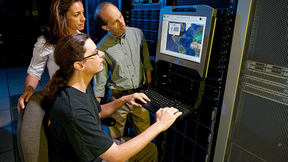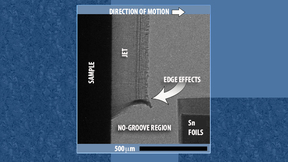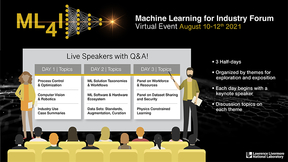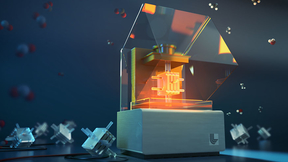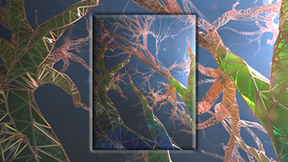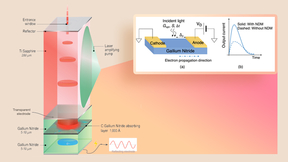Back
For much of the past decade, Lawrence Livermore National Laboratory (LLNL) researchers have been designing major optical components for the world’s newest telescope, while their industrial partners have fabricated the components. Now, with the September shipment of the last of six optical filters for the telescope’s camera to the SLAC National Accelerator Laboratory in…
When Daniel Martin put the finishing touches on an autonomous vehicle robot, complete with an ultrasonic sensor to detect and evade obstacles, he knew he wanted to become an engineer. A high school student at the time, he was fascinated by the design and functionality of robots. Fast forward several years, and Martin is now a second-year electrical engineering Ph.D…
Lawrence Livermore National Laboratory (LLNL) scientists and engineers have posted another banner year securing major grants through the Department of Energy’s (DOE) Technology Commercialization Fund (TCF). “I think the Laboratory did very well again, reflecting a variety of types and approaches to our research and development projects,” said Rich Rankin, the director of…
While laser-based 3D printing techniques have revolutionized the production of metal parts by greatly expanding design complexity, the laser beams traditionally used in metal printing have drawbacks that can lead to defects and poor mechanical performance. Researchers at Lawrence Livermore National Laboratory (LLNL) are addressing the issue by exploring alternative shapes…
The Department of Energy’s National Nuclear Security Administration’s (DOE/NNSA’s) Lawrence Livermore National Laboratory (LLNL) announced the awarding of a subcontract to Dell Technologies for additional supercomputing systems to support NNSA’s nuclear deterrent mission. In partnership with Los Alamos National Laboratory (LANL) and Sandia National Laboratories (SNL), the…
LLNL held its first-ever Machine Learning for Industry Forum (ML4I) on Aug. 10-12. Co-hosted by the Lab’s High Performance Computing Innovation Center (HPCIC) and Data Science Institute (DSI), the virtual event brought together more than 500 participants from the Department of Energy (DOE) complex, commercial companies, professional societies and academia. Industry…
To celebrate Manufacturing Day 2021, the High Performance Computing for Energy Innovation (HPC4EI) initiative will hold a special webinar on Oct. 1 featuring speakers from the Department of Energy (DOE), presentations by DOE scientists and students and virtual tours. The free event runs from 7:30 a.m. to 12:30 p.m. PDT and is open to all. The webinar’s plenary session…
A Lawrence Livermore National Laboratory-led effort in data compression was one of nine projects recently funded by the U.S. Department of Energy (DOE) for research aimed at shrinking the amount of data needed to advance scientific discovery. LLNL was among five DOE national laboratories to receive awards totaling $13.7 million for data reduction in scientific applications…
Lawrence Livermore National Laboratory (LLNL) and its three partner national labs in the Bay Area Lab Innovation Networking Center (LINC) will offer a webinar about the future of semiconductors and advanced materials on Wednesday, Aug. 25. The two-hour virtual Zoom webinar, called “Over the Horizon” and set to start at noon Pacific time, is primarily targeted at Bay Area…
Zach Dunn has always enjoyed working on cars and building things with his hands. Deciding a four-year college wasn’t for him, he pursued the trades as a machinist, joining Lawrence Livermore National Laboratory’s prestigious Machinist Apprentice Program in 2017 right out of high school. On July 29, Dunn became one of five recent graduates of the program for 2020 and 2021…
Lawrence Livermore National Laboratory (LLNL) hosted an in-person orientation meeting recently for members of the National Nuclear Security Administration’s (NNSA) Test Site Verification Team (TSVT). TSVT is sponsored by NNSA’s Office of Nuclear Verification (ONV) Nuclear Compliance Verification (NCV) Program. The TSVT is led by Kim Knight from LLNL and Emily Schultz…
To take advantage of the growing abundance and cheaper costs of renewable energy, Lawrence Livermore National Laboratory (LLNL) scientists and engineers are 3D printing flow-through electrodes (FTEs), core components of electrochemical reactors used for converting CO2 and other molecules to useful products. As described in a paper published by the Proceedings of the…
Lawrence Livermore National Laboratory (LLNL) scientists have experimentally tested the predictions of a 2020 study that computationally investigated the effect of melting on shock driven metal microjets. That earlier work predicted that melting the base material does not necessarily lead to a substantial increase in jet mass. The LLNL team confirmed the predictions of…
A polymer production enclave, in partnership with the Kansas City National Security Campus (KCNSC) and Lawrence Livermore National Laboratory (LLNL), is on budget and on schedule to bring modern technology into the Nuclear Security Enterprise. The enclave will enable rapid development of design and production processes of polymer parts for modernization programs. This…
A polymer production enclave, in partnership with the Kansas City National Security Campus (KCNSC) and Lawrence Livermore National Laboratory (LLNL), is on budget and on schedule to bring modern technology into the Nuclear Security Enterprise. The enclave will enable rapid development of design and production processes of polymer parts for modernization programs. This…
Registration is open through July 29 for the first-ever Machine Learning for Industry Forum (ML4I), a three-day virtual event starting Aug. 10. The forum aims to foster and illustrate the adoption of machine learning methods for practical industrial outcomes, with a strong emphasis on manufacturing. Over the course of the event, attendees will engage in dialog about…
Lawrence Livermore National Laboratory (LLNL) scientists and their collaborators are leveraging the power of 3D printing to improve the performance of electrochemical reactors used to convert carbon dioxide (CO2) to useful energy sources, chemicals and material feedstocks. Working under a cooperative research and development agreement (CRADA) with Stanford University and…
Reshaping the exterior of heavy vehicles, such as semitrucks, so that they are aerodynamically integrated along their entire length in a smooth, continuous fashion could reduce drag, increase fuel efficiency and cut carbon emissions. Using wind tunnel measurements and computational fluid dynamics simulations, Lawrence Livermore National Laboratory (LLNL) engineers have…
Inspired by the way plants absorb and distribute water and nutrients, Lawrence Livermore National Laboratory (LLNL) researchers have developed a groundbreaking method for transporting liquids and gases using 3D-printed lattice design and capillary action phenomena. In a paper published today in Nature and featured on the publication’s cover, LLNL researchers describe 3D…
Lawrence Livermore National Laboratory (LLNL) engineers have designed a new kind of laser-driven semiconductor switch that can theoretically achieve higher speeds at higher voltages than existing photoconductive devices. The development of such a device could enable next-generation satellite communication systems capable of transferring more data at a faster rate, and over…





